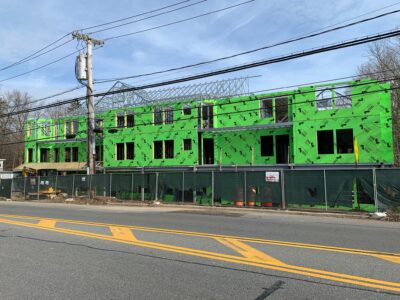
When Kristen Browde’s son Theo came home from Horace Greeley, where he’s a sophomore, and told her about a second mandatory lockdown drill, Browde said her decision was made up to run for state assembly in New York’s 93rd district. “This generation has grown up with the fear that their school could be next.”
Browde, who has sat on the Chappaqua School Board’s financial advisory committee for almost ten years, said one of the things the committee often has talked about is how to “harden” our schools, but her contention is that security measures inside schools are not nearly enough.
“It remains easier in New York, in spite of our SAFE Act and red flag laws and all the progress we have made, to buy a high powered weapon–a military style weapon–and ammunition, than it is to buy a pack of Sudafed–and that is just wrong.”
A former TV broadcaster, Browde cited experience that includes decades of effective lobbying in Albany as a national and local officer for and on behalf of The American Federation of Television and Radio Artists (now SAG-AFTRA). She worked on legislation to ban the use of non-compete contracts that kept industry salaries low or stagnating.
“When I worked at Channel Five and Channel Four, the broadcast companies would put a non-compete clause into our contracts. This would say ‘even after you leave my station, you cannot go to work for anybody else in this market for a certain amount of time.’ The result of that was that the employee’s bargaining power was substantially reduced because you would have to sit out six months or even a year without a salary–and that is how they kept you where you were at a lower salary, too. “It took seven years to get it passed. Back then, the Republicans were controlling the state legislature.” Browde proudly stated that she finally helped pass the Broadcast Employees Freedom to Work Act.
 “And now that the State Senate (a last bastion of the Republicans), has flipped, all of a sudden, bills that had been bottled up for years… were finally able to be brought to the floor and enacted into laws signed by Governor Cuomo.
“And now that the State Senate (a last bastion of the Republicans), has flipped, all of a sudden, bills that had been bottled up for years… were finally able to be brought to the floor and enacted into laws signed by Governor Cuomo.
“In recent years I have had the opportunity to build relationships with people like the Governor and with the leaders of both houses, in the course of working on these issues. I know who they are and who we need to work with to make changes happen.”
Gun violence prevention will be her top priority. “Every parent who puts their kid on a school bus in the morning wants one thing–to get that kid back at the end of the day. It is not just the kids that are growing up with this fear, parents are as well. We are having to spend huge sums of money on school security… But if we can protect just a little bit more and at no cost, we ought to be doing that… Do the background checks and do the positive identification. You don’t stop with the weapons; it’s about the ammunition too. Moms Demand Action has a tremendous legislative program, so does the Brady Campaign. Both have absolutely solid things that this legislation should be working on in the next session.”
Browde cited another critically important legislative task ahead: redistricting.
“We are going to have a census. It is almost certain that New York is going to lose a Congressional seat… Nita Lowey’s seat is a pretty safe Democratic seat. Sean Patrick Maloney’s is not. There are lines that are almost certainly going to be redrawn… We will need to protect the sanctity one person, one vote, rather than protect the sanctity of an individual politician. We have seen that in places like North Carolina what happens when you have tremendously gerrymandered districts that pack all the Democrats into one tiny little area: the Republicans, even though they are only 50% of the state, control 75-80% of the Congressional seats. We can’t let that happen anymore.”
The conversation veered into today’s antisemitism which hits close to home for Browde. “My father’s family fled Germany on Kristallnacht and his dad, my grandfather, didn’t get out, but his mom did.”
“Whether it is, anti-Jewish, anti-Black, anti-Hispanic, we have to use every single resource that is humanly possible to bring to bear to battle hate… That’s a conversation that we in New York can start. Frankly, we in New York have the biggest problem with it right now.
At this juncture, Peter Moses, Browde’s campaign advisor and a longtime journalist himself, pointed to Browde being “incisive, direct, and a listener” as key strengths during her media career. It’s that same skill set, he said, that helped her pass legislation in Albany.
“It is why (Westchester County Executive) George Latimer has her on a couple of committees. The fact that she’s really bright may have influenced him, but what keeps her there, what she keeps bringing to the table with all the new roles she takes on, is her ability to communicate and listen.”
Melding Career Strengths Toward Key Consensus Building
“I’ve gone from reporter to divorce lawyer, which I used to describe as combining the two least respected professions in America into one stellar career, Now I’m adding politician, so it’s a trifecta,” Browde chimed in with a smile.
“As a divorce lawyer, you are dealing with people who at one point said they love each other and now can’t see eye to eye about anything and you are trying to bring them together to a settlement that they can both live with. When you are doing a job of a legislator, or let’s say, someone who is trying to persuade other legislators to come over to your side, you are doing the same thing. People who want the same thin–which is the best for the people of the state of New York.”
“I’m also trying to figure out what the other person really needs, because frankly, while I don’t agree with the policy positions espoused by most Republicans, the fact is I don’t think they are bad people. I just think they have a different view of what is best…there are common points and if we can get together on those common points, then that is fine.
Browde reminded me too that “the sticking point right now is not the Republicans. In Albany today, Democrats control all three houses, the two houses of the legislature and the Governor’s mansion, which are the three critical points of power in Albany. The problem is that the Democrats in the Assembly often can’t reach an agreement. I’m pretty good at getting Democrats together… and have worked with people across the party, from the extreme left to the more conservative members of the party… and we got bills through and we got bills signed.”
“It is less about policy differences than effectiveness,” said Browde. “What I have shown is that first off, I don’t stop. I don’t stop. I am good at bringing people together who don’t start agreeing… the only effective way to work in a legislative setting is to build coalitions.”
Browde shared her optimism in the challenge to win the seat with “approximately 90,000 registered voters stretched out from Harrison and White Plains up to the Connecticut line.”
“I am not Michael Bloomberg, I am not self-financing, so we are doing the same thing that everybody else is which is raising money through various Democratic Party channels: “People get fired up about my campaign–they’re visiting us at KristenForNY93.com. People are energized about the political process in general right now. The June 23rd primary is the focus right this minute, and then it is off to November!”


